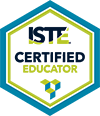Data and Art: Data Science in Elementary
,
Colorado Convention Center, Bluebird Ballroom Lobby, Table 5
Presenters




Session description
Purpose & objective
Participants will leave this poster presentation with a deeper understanding of what Data Science can look like at the K-5 level, as well as with a knowledge of resources that they can use (books for teachers and for students, and materials developed for South Fayette students that can be modified to fit different contexts). After attending this presentation, participants will be able to identify times in their school day where students/teachers are already collecting data and how those instances can be expanded upon to include conversations about data science.
To engage participants, I will have both photos/videos of data science work being done at South Fayette Elementary, and also, physical samples of students' projects so that participants can see what K-5 students are capable of achieving with data science.
Explanations of how students move from gathering to analyzing data, and then representing data through visual art will be detailed for participants. A timeline of what this process looks like through out the year at different grade levels will be provided, as well as examples of how we are evaluating students for understanding.
This presentation will be considered a success if participants leave the conversation interested in learning more about data science at the elementary level and if they can begin to identify areas in their school routines where data science could be introduced.
Outline
The main focal points of my poster session will be:
1. Focusing on how data science is introduced at different elementary grade levels and what that might look like with concrete examples of activities.
2. Explaining how students go from gathering data to analyzing it, with attention to how students can use data to draw specific conclusions.
3. Showing students' visual representations made using data and combining it with physical art.
I will speak with each attendee, but they will also have access to QR codes that lead to students' projects/reflections, and some of our classroom materials (handouts).
Supporting research
Boaler, J. (2015). Mathematical mindsets [EPUB]. Jossey Bass Wiley.
Boaler, Jo. (2022). Seeing Is Achieving: The Importance of Fingers, Touch, and Visual Thinking to Mathematics Learners. 10.7551/mitpress/13593.003.0015.
LaMar, Tanya & Boaler, Jo. (2021). The importance and emergence of K-12 data science. Phi Delta Kappan. 103. 49-53. 10.1177/00317217211043627.
Murphy Paul, Annie. “The Coding Revolution.” Scientific American Aug. 2016:42-49. Online and Print.
Rondinelli, Bille, Dr., and Aileen M. Owens. “Computational Thinking.” AASA May 2017: 23-27. Print and Online.
Session specifications
Knowledge Constructor
- Students plan and employ effective research strategies to locate information and other resources for their intellectual or creative pursuits.
- Students collect data or identify relevant data sets, use digital tools to analyze them, and represent data in various ways to facilitate problem-solving and decision-making.
- Students communicate complex ideas clearly and effectively by creating or using a variety of digital objects such as visualizations, models or simulations.
 Return
Return Participate and share: Poster
Participate and share: Poster  Trips and Tours
Trips and Tours